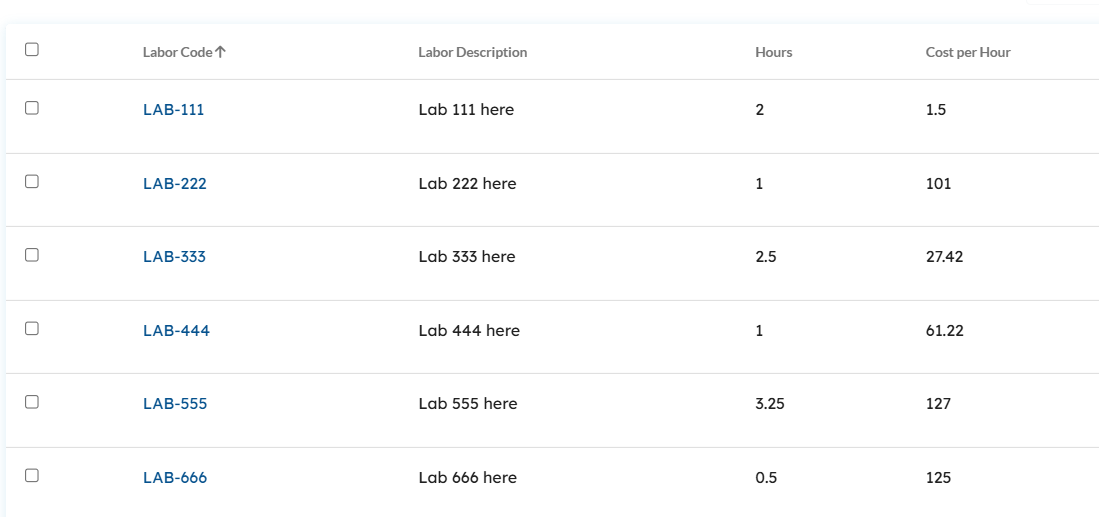The Agent Portal is designed for agents to efficiently manage client requests, track progress, and perform other agent tasks. It provides easy access to various tools, including RMA management, reports, dashboards, and more.
Agent Portal Features
Homepage
There is a left navigation pane to access all items available to the logged-in Agent.
A Favourites section for quick access to frequently used items. The Agents can personalise what is their favorites.
Lists serve as the main tool for accessing all relevant data objects (RMAs, Tickets, Companies, etc.)
Reports and Charts and Dashboards available to the logged in Agent.
.png)
Agent Portal: Homepage
Manage Companies
Provides the ability to manage company information.
Client accounts are associated with a Company. A Company can have 1 or more client accounts.
Each Client has access to his/her RMAs and Tickets in the Client Portal.
Company List
Displays a list of all companies in the system.
Supports exporting and importing company information via CSV and Excel files.
Allows adding, editing, and deleting companies.
Company Information
Opening a company record provides access to the following:

Enables management of company main, shipping, and billing addresses.
Client User Management: Add and manage client user accounts associated with the company. View and manage individual client information.
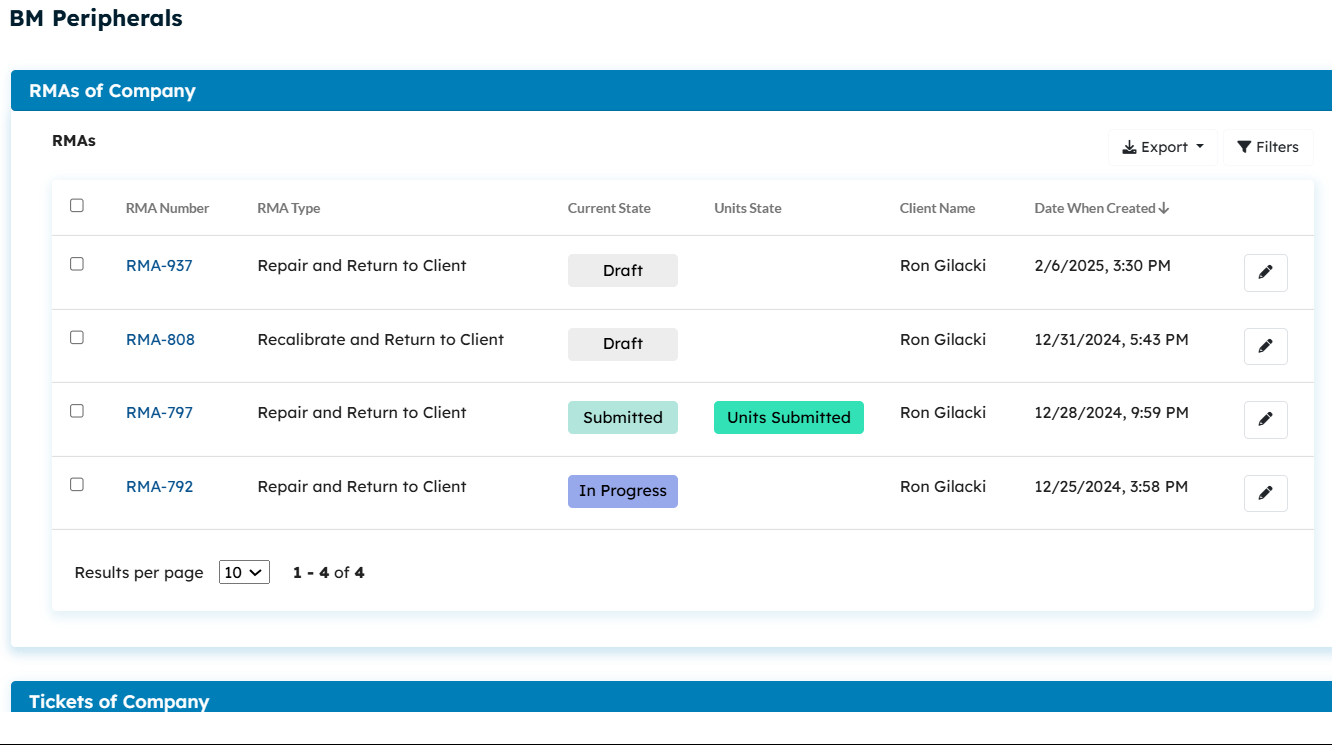
RMA Management: View and manage all RMAs created for clients of the Company.
Ticket Management: View and manage all support tickets created for clients of the Company.
Manage Clients
Client user accounts are created by agents, allowing them to manage these accounts.
Manage clients.
Add, edit, and delete clients. Adding a new client user automatically creates an account and login credentials for Client Portal access.
View a list of all clients.
Client Information
Opening a client record provides access to the following information and management tools:
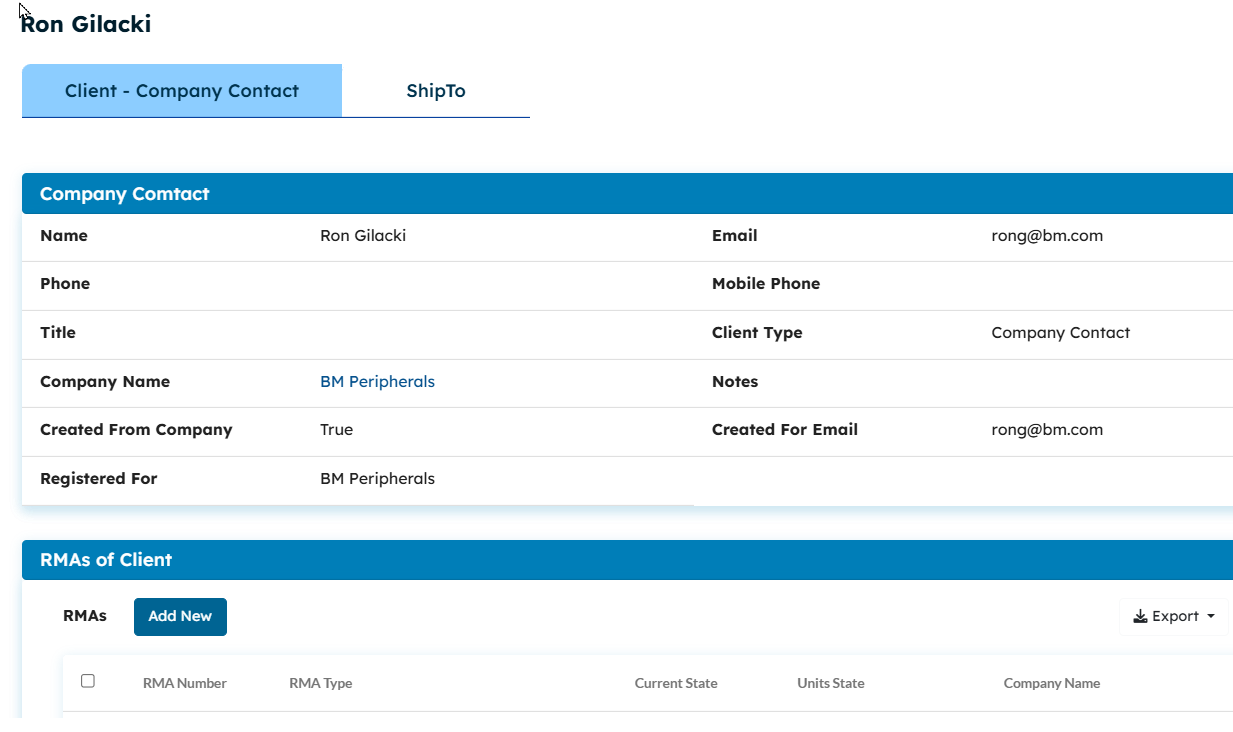
Manage Client Contact Informantion: name, phone, email, etc.
RMA Management: Create RMAs on behalf of the Client (Clients can of course add RMAs in the Client Portal). View and manage RMAs of the Client.
Ticket Management: Create Tickets on behalf of the Client (Clients can of course add Tickets in the Client Portal).. View and manage tickets of the Client.
ShipTo (Returns) Address Management: Manage the client's returns shipping address.
Manage RMAs
Submitted RMAs are managed by agents through a workflow using state transitions.
States & Workflow
The available RMA states (e.g., Draft, Submitted, RMA Approved, RMA Rejected, In Progress, Hold, Received, Credited, Advance Replacement Sent, Shipped, Quote Sent To Client, PO on Quote Received, Closed) are configurable by the administrator. New states can be added, and existing states can be renamed.
Separate workflows exist for four standard RMA types: Credit, Advance Replacement, Repair and Return to Client, and Recalibrate and Return to Client. RMA state changes are type-dependent. (See the RMA Workflow diagram and individual workflow diagrams for each RMA type for details.)
RMA Unit Management
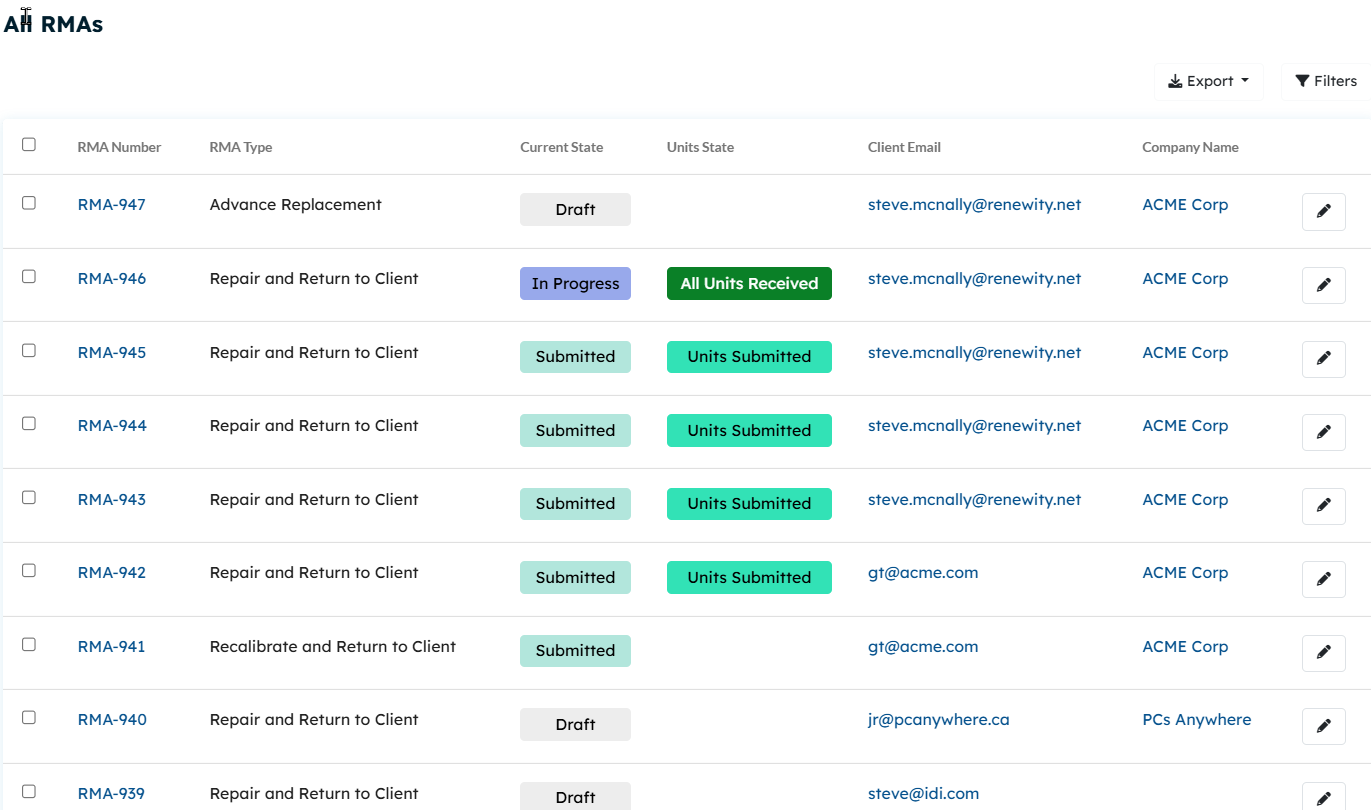
List all RMAs. List shows RMA Number, RMA Type, current RMA State, Units State, Client, and Company.
Each unit has its own workflow and state transitions based on its RMA Type.
Unit-related information is captured for each unit.
RMA Data Management
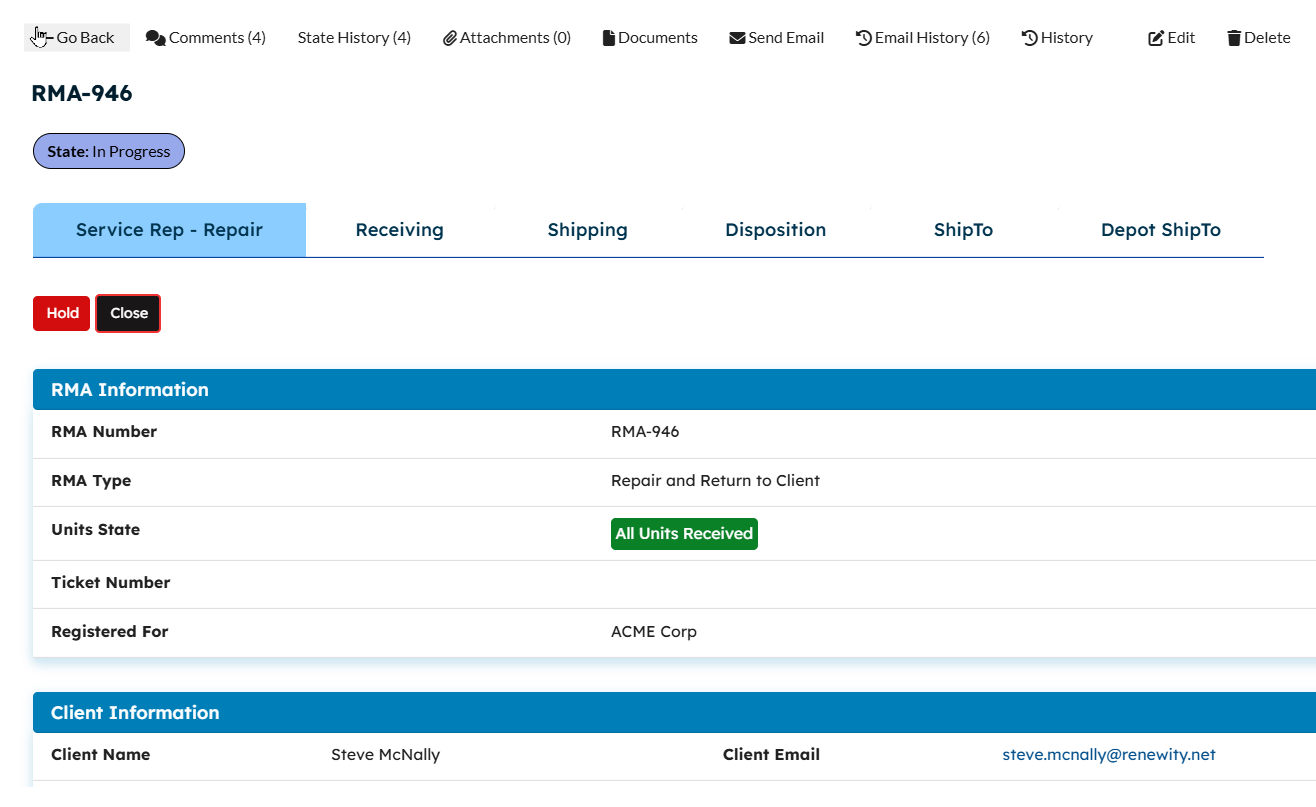
Open a specific RMA and manage its data and workflow.
Manage RMA information on receieving, shipping, disposition,etc.) These groups of data are confogurable by Admin.
Edit and modify RMA data throughout the workflow, including Receiving, Shipping, Disposition, ShipTo Address, and Depot ShipTo Address.
Add attachments to the RMA.
Add and view comments on the RMA which are sahed with the Client in the Client Portal.
Access, download, and view RMA documents (e.g., Test Results, QA Approvals) in PDF format.
Communication & Collaboration
Send emails internally to Agents and to the Client, including any RMA data fields in the email.
Utilize email templates (canned responses).
Add attachments and documents to emails.
Clients can respond to emailson the RMA in theri email app and their email responses are added to the Email History of the RMA.
History & Reporting
State History: View all RMA state changes with date and time stamps and Agent who made the change..
Email History: View all emails sent and received regarding the RMA.
Object History: A complete audit trail is maintained for each RMA, including a history of all field changes, triggered automations (triggers and actions), and state changes. The history includes date and time stamps and identifies the agent responsible for each change.
Charts & Reports: Agents can access charts and reports on RMAs, as configured by the administrator.
Lists
Various lists are available in the portal for easy access to RMAs, including All RMAs, Submitted RMAs, Closed RMAs, and In Progress RMAs.
Manage Tickets
States & Workflow
State Transitions: Agents can change the state of a ticket. Default states include Submitted, Assigned, Taken On, Resolved, and Closed, but these are configurable and can be extended by the administrator.
Ticket Data Management
List All Tickets filtered by State, Client, and Company.
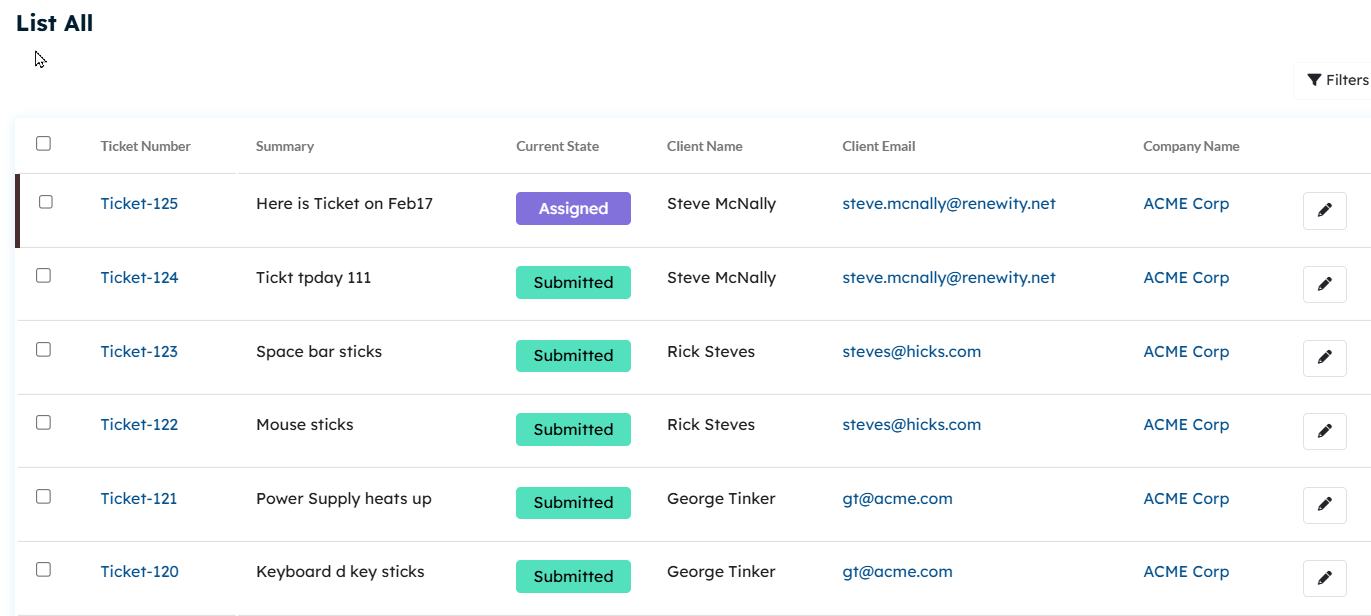
Data Entry & Modification: Agents can add and modify ticket data throughout the ticket lifecycle.
Attachments: Agents can add relevant file attachments to tickets.
Add RMA to Ticket: Agents can create and associate an RMA with a Ticket. The RMA is linked to the client and the client's company.
Create Ticket (on behalf of client): Agents can create tickets for clients.
Communication & Collaboration
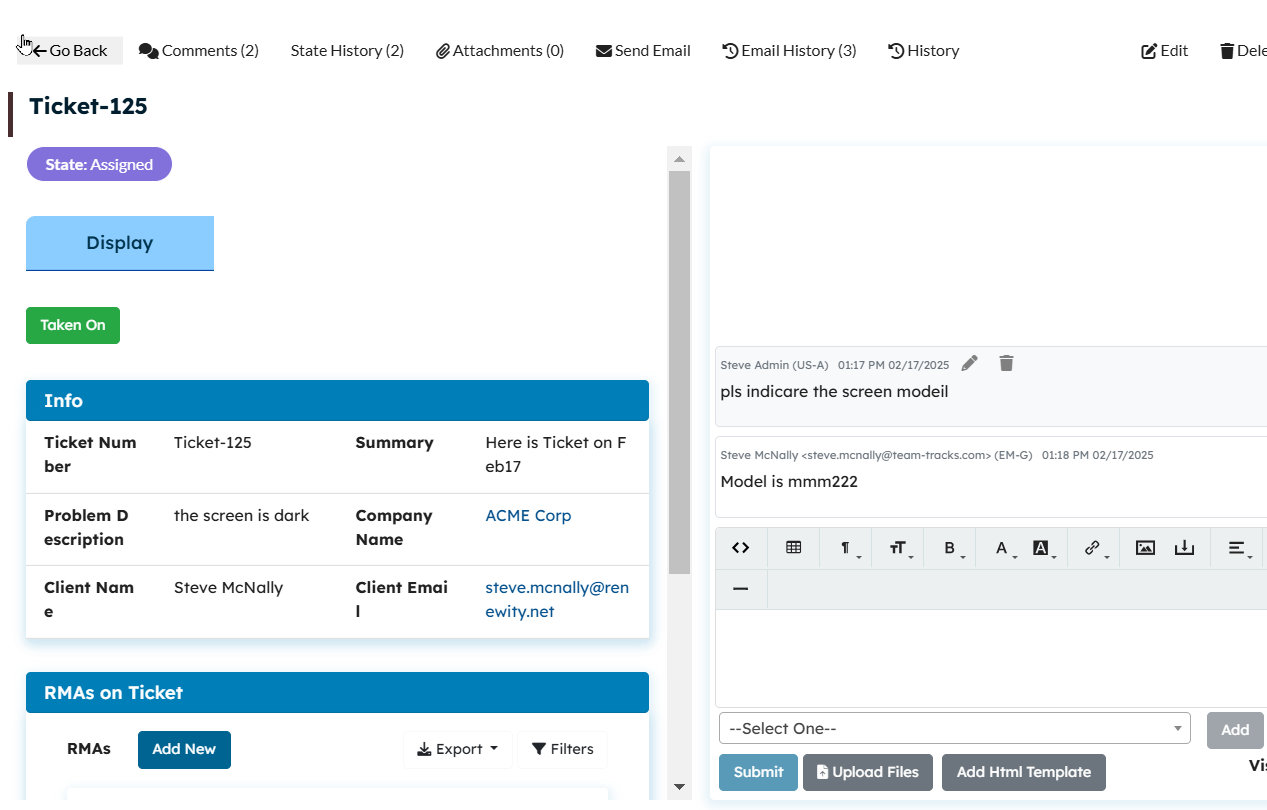
Client Communication (Comments):
Agents can add comments to tickets for clients to view in the client portal.
Agents can include any icket data fields within comments.
Email Communication:
Agents can send emails to clients, including documents, attachments, and ticket data.
Agents can utilize email templates (canned reaponses).
Email Integration:
Agent comments are automatically sent to the client via email.
Agent emails are also added as comments to the ticket.
Client can respond to emails in their email app inbox and their email responses are added to both the email history and the ticket comments.
History and Reporting
Object History: A comprehensive audit trail tracks all ticket activity, including field changes, automated actions (triggers and actions), and state changes, with date/time stamps and agent identification.
State History: Agents can view the history of state transitions for a ticket, including date/time stamps and the agent responsible for each change.
Email History: Agents can view all emails sent and received regarding the ticket.
Charts & Reports: Agents can access charts and reports on tickets, as configured by the administrator.
Lists
Various lists are available in the portal for easy access to tickets including All Tickets, Submitted, Assigned, Resolved and Closed Tickets.
Master Data Management
The template utilizes various tracks to store and manage master data, such as Serial Number and Warranty information, Parts and Labor uses in Repairs. Each track contains specific fields to store relevant data for each record within that table.
Master Data tracks in RMA Template
Common Table Functions
View Records:
Display a list of all records within the table, including all associated field values.
Add Records:
Manual Entry: Add individual records manually.
Excel Import: Import multiple records from an Excel file.
API Integration: Import records via API calls from external systems (e.g., ERP).
Delete Records: Remove existing records from the table.
Edit Records: Modify the field values of existing records.
Serial Number Table
The Serial Number Table contains critical information about all units eligible for RMA process.
Key Components
Serial Number | Unique identifier for the unit. |
Warranty End Date | Date when the unit's warranty expires. |
Registered Company | Company to which the unit is registered. |
Unit Specifications | Product, Model Number, and other relevant unit data. Any number of data fields can be added. |
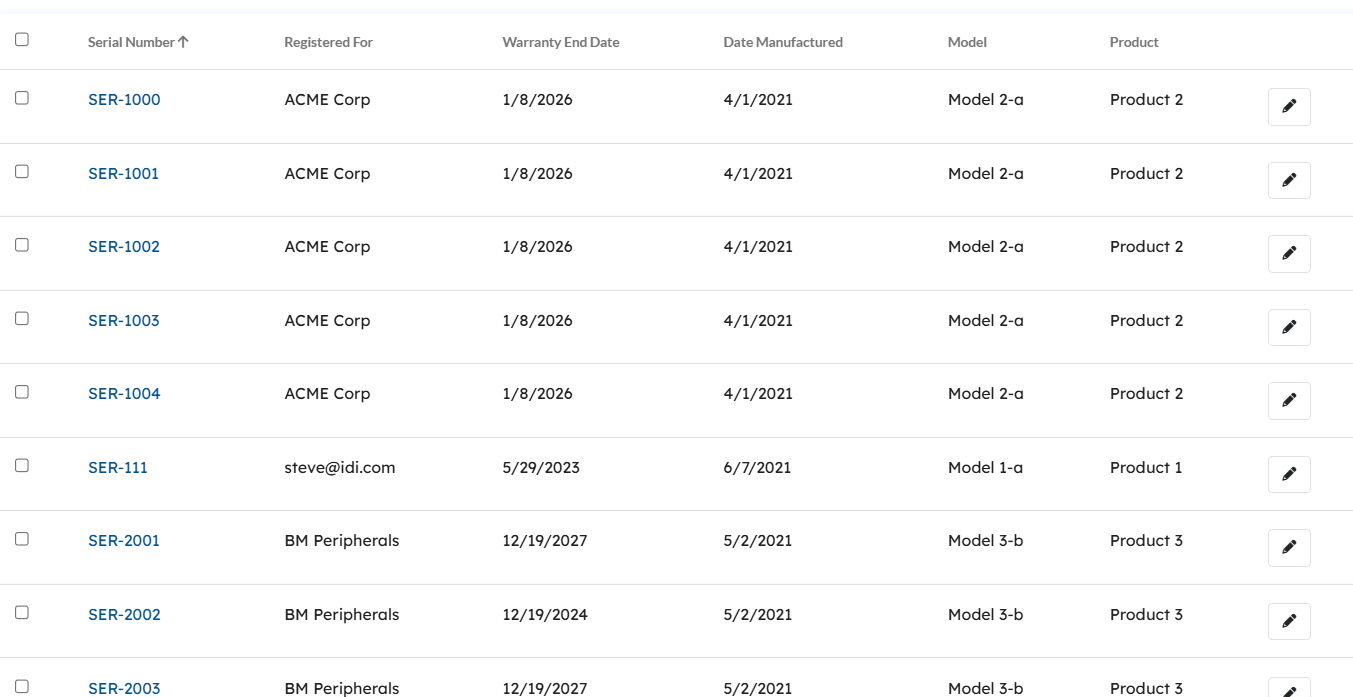
Data Utilization
Warranty Verification:
During RMA creation, the system checks the warranty status of entered units against the Serial Number Table.
The warranty status (under warranty/out of warranty) is displayed to the client.
RMA Unit Data Population:
Unit specifications from the Serial Number Table are automatically populated into the RMA unit fields, saving time and reducing data entry errors.
Note:
Client users who are not associated with a company can manage their products through a separate 'Registered Products' list.
Parts Table
The Parts Table serves as a central repository for all parts that can be used in unit repairs.
Key Components
Each record in the table represents a unique part, containing:
Part Number | Unique identifier for the part. |
Part Description | Detailed description of the part. |
Price | Cost of the part. |
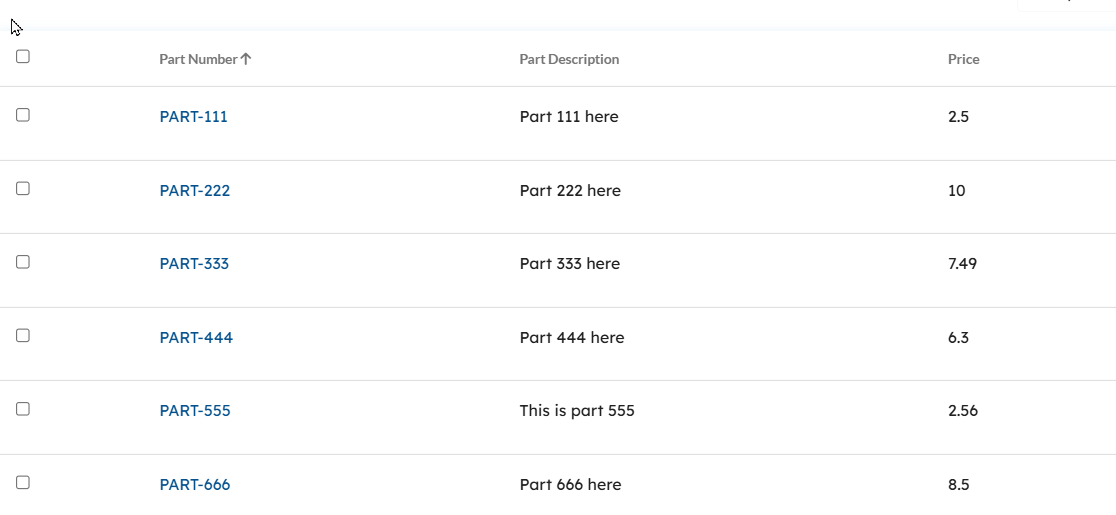
Data Utilization
RMA Unit Repair: When repairing a unit, agents can select parts from the Parts Table to build a repair quote and/or keep track of the repair.
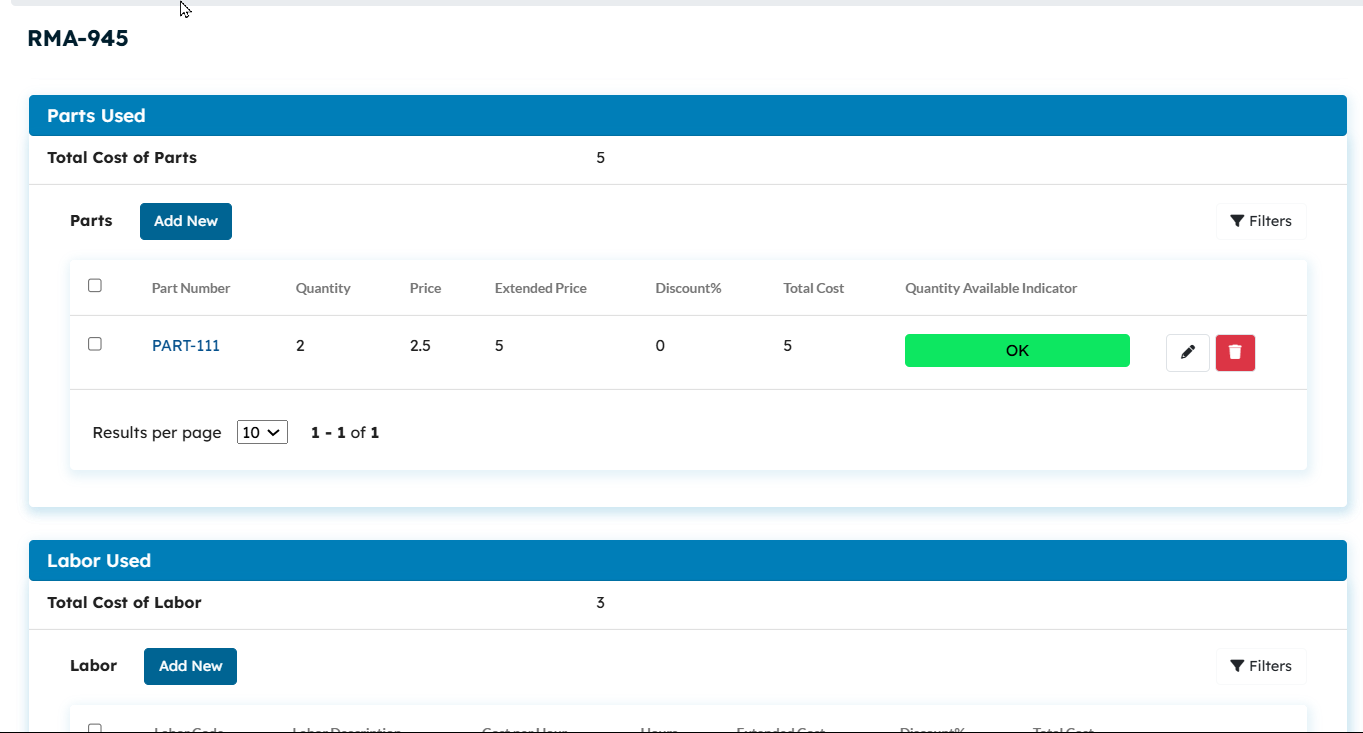
Unit Cost Calculation: The system automatically calculates the total cost of all parts used for a particular unit repair.
Quote Generation: The Parts Table data is used to generate and send repair quotes to clients for approval.
Labor Table
The Labor Table maintains a record of standard labor codes used in unit repairs.
Key Components
Each record represents a specific labor code
Labor Code | Unique identifier for the labor code. |
Labor Description | Detailed description of the labor task. |
Hours | Standard number of hours required for the labor task. |
Cost Per Hour | Labor cost per hour. |
DataUtilization
Unit Repair: When repairing a unit, agents can select applicable labor codes from the Labor Table.
Labor Cost Calculation: The system automatically calculates the total labor cost for a unit repair based on the selected labor codes, hours, and cost per hour.
Quote Generation: The Labor Table data is used to generate and send repair quotes to clients for approval.
Spare Parts Inventory
The Spare Parts Table maintains a record of all spare parts available for use in unit repairs. This acts as a simple inventory management system.
Key Components
Each record represents a specific spare part.
Part Number | Unique identifier for the part. |
Part Description | Description of the part. |
Quantity Available | Number of spare parts currently in stock. |
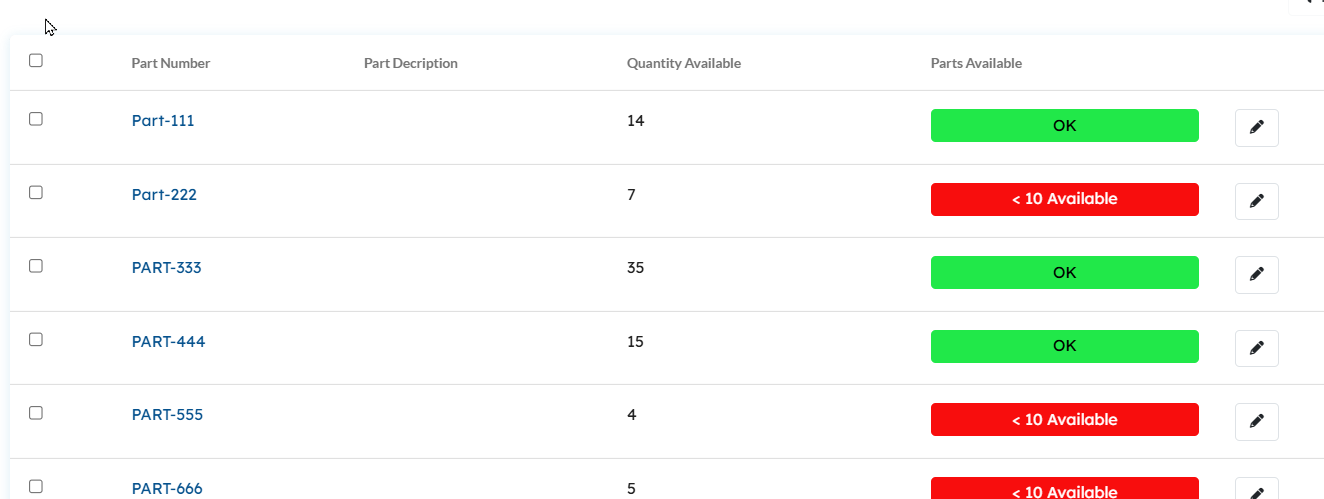
Inventory Management & Usage
RMA Usage: When a spare part is used to repair a unit, the system automatically reduces the "Quantity Available" in the Spare Parts Table.
Low Inventory Alerts: If the "Quantity Available" for a spare part falls below a configurable threshold (e.g., 10 units), the system generates a warning to the agent when they attempt to use that part for a unit repair.
Inventory Replenishment: Agents can manually increase the quantity of spare parts in the table to reflect new inventory arrivals.
Manage Depot Locations
Depots are the designated locations where clients are instructed to ship their units for repair.
Key Functions
Add Depots: Create new depot locations with full address information.
Edit Depots: Modify existing depot addresses as needed.
List Depots: View a complete list of all configured depot locations.
Delete Depots: Remove depot locations that are no longer in use.

Data Utilization
Depot Selection: During RMA approval, agents are prompted to select the appropriate DepotShipTo location where the client should ship the unit.
Email Communication: Depot addresses are automatically included in emails sent to clients regarding their RMA, providing clear shipping instructions.
Manage Agents
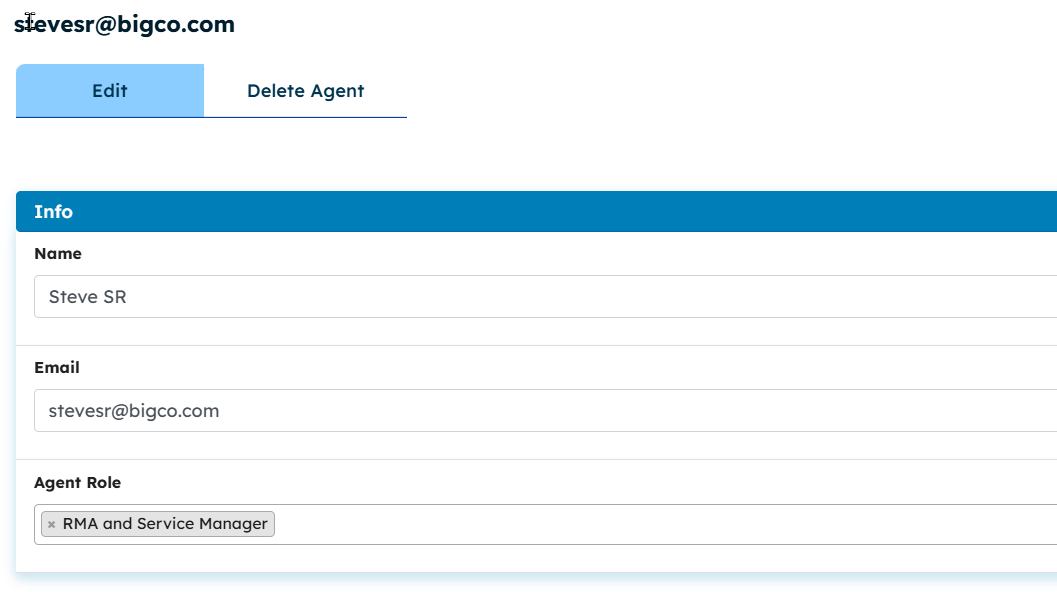
Add Agent Licenses: Create new agent accounts with the necessary permissions to access and utilize the RenewityRMA system.
Agent List: View a list of all active agents within the system.
Edit Agent Information: Update agent details such as contact information, permissions, and access levels.
Knowledge Base
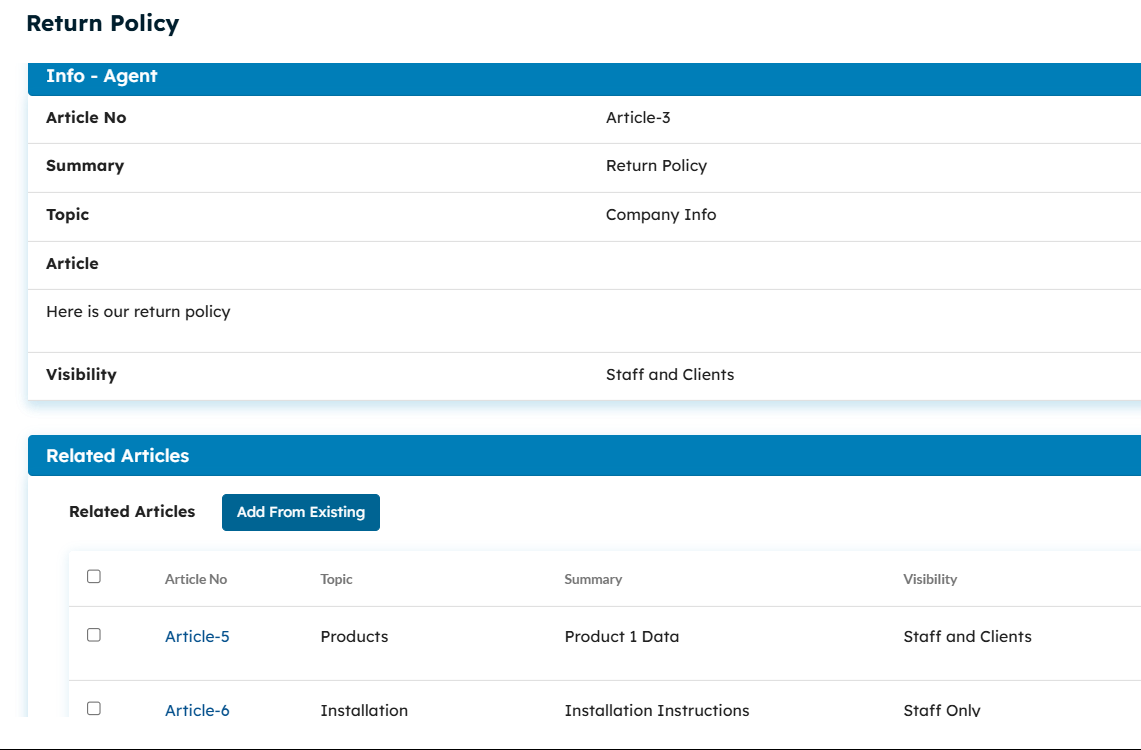
List: View all available KB articles.
View: Access and view the content of individual KB articles.
Add: Create new articles.
Edit: Modify existing KB articles.
Delete: Remove KB articles from the system.
Comments: Allow users (both agents and clients, depending on article visibility) to add comments to KB articles for discussion and feedback.
Visibility: Specify visibility of the Article (Agent only, Client and Agents)

